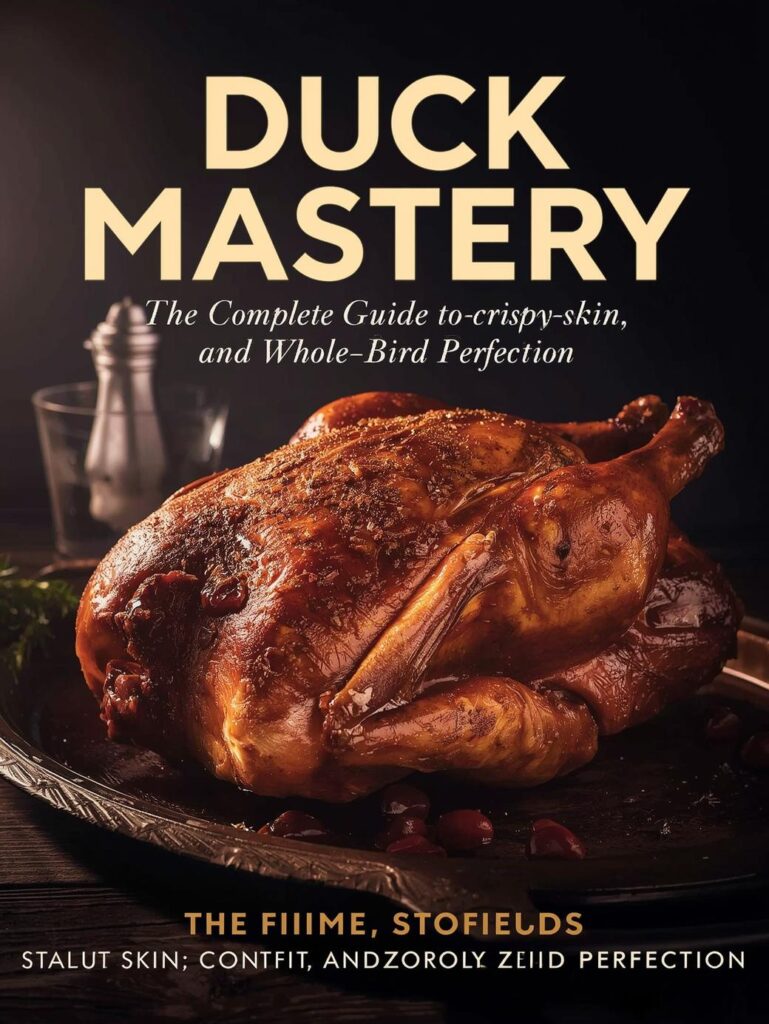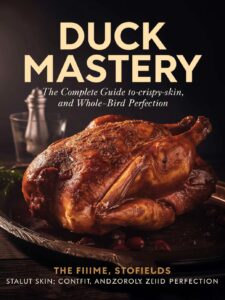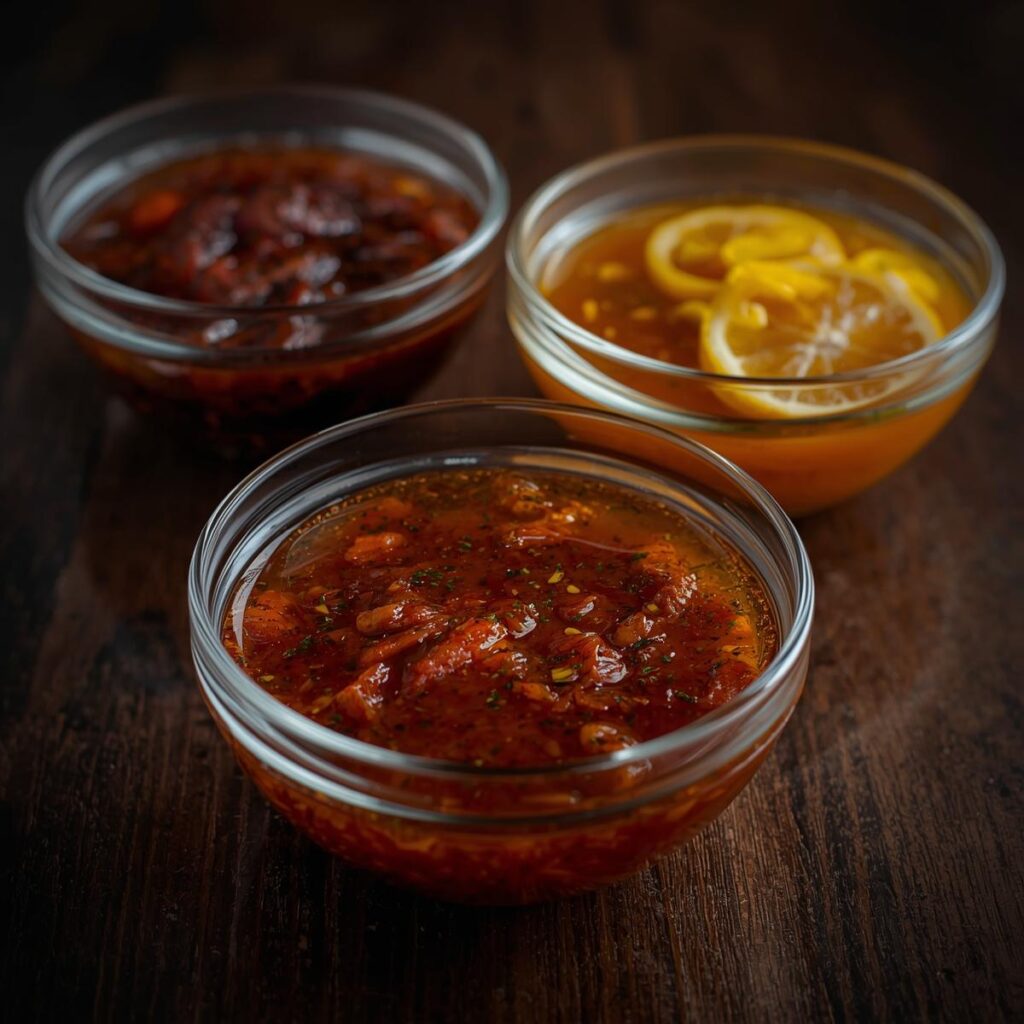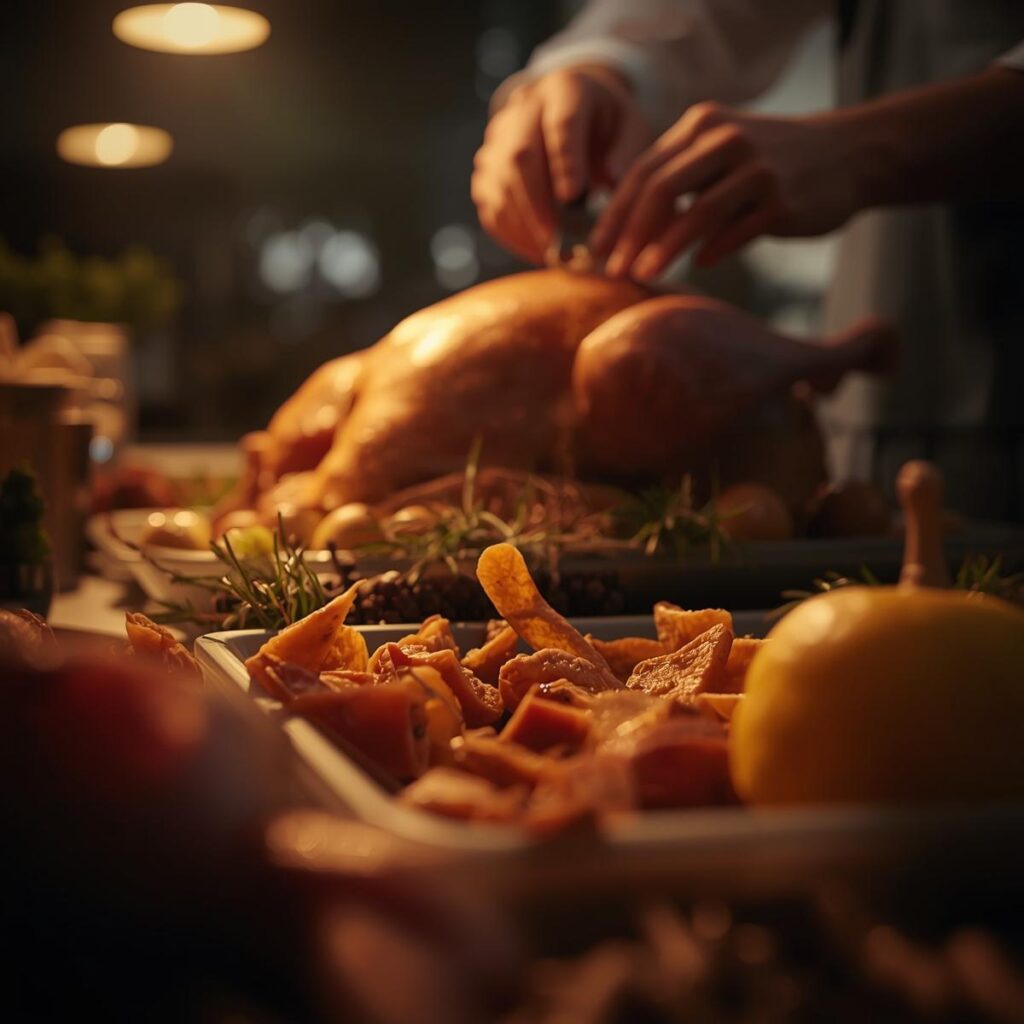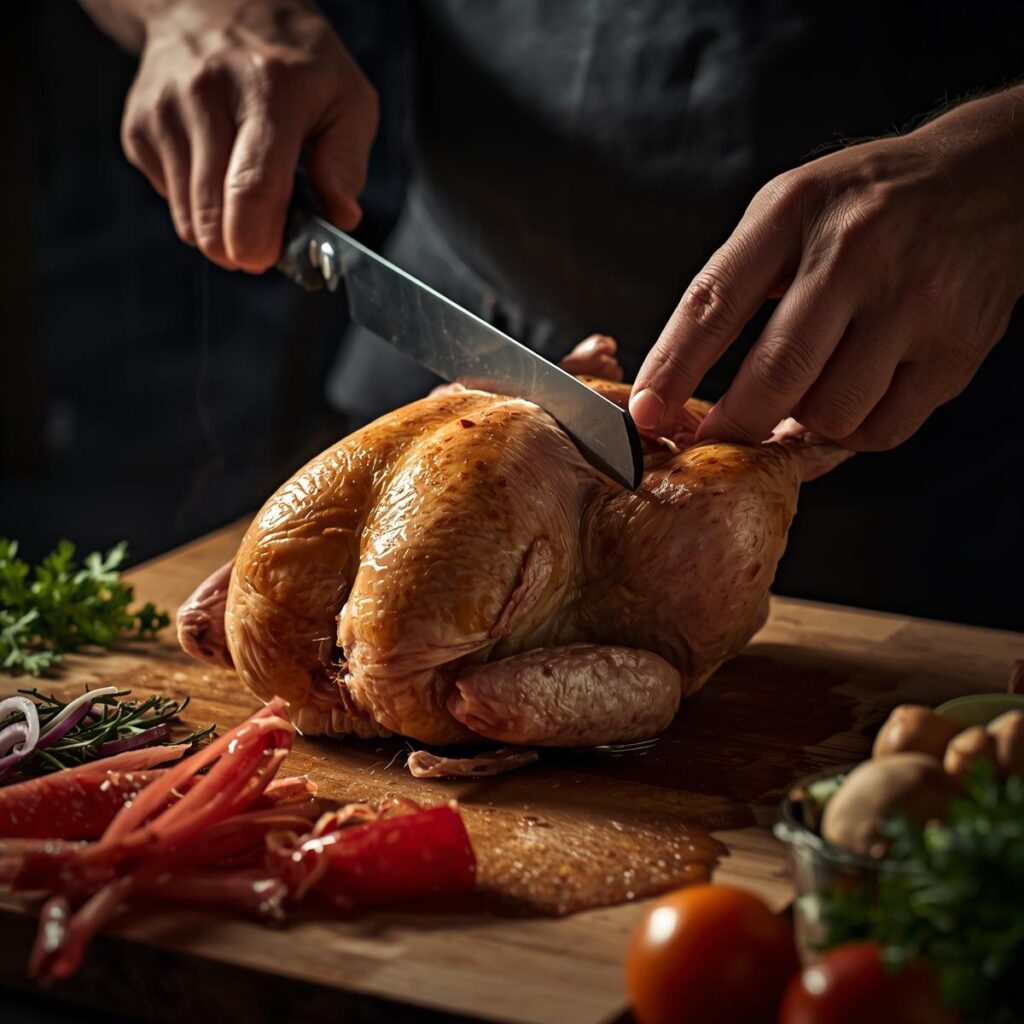The Ultimate Dual-Purpose Bird: Duck is the culinary shape-shifter—a single animal that contains within it the possibility of both the crispiest skin imaginable and the most unctuous, falling-apart tender meat. Where other poultry demands you choose between tenderness and flavor, duck gives you both: the lean, red-meat breast for searing and the fat-rendered, collagen-rich legs for braising. Master duck, and you master the entire spectrum of cooking techniques in one magnificent bird.
Duck Mastery: The Complete Guide to Crispy Skin, Confit, and Whole Bird Perfection
“Duck is the philosopher’s protein—it teaches you that fat is not the enemy but the vehicle to perfection. That thick layer beneath the skin isn’t something to remove; it’s liquid gold waiting to transform into crackling or confit. Cooking duck isn’t about fighting its nature but understanding its duality: the breast wants hot and fast, the legs want low and slow. Embrace this contradiction, and you’ll unlock one of the most versatile animals in the culinary world.”
Duck Mastery: The Complete Guide to Crispy Skin, Confit, and Whole Bird Perfection
Download Our Duck Mastery Guide - Cuts, Methods & Temperature Chart
Most home cooks approach duck with either fear or limited vision—seeing only the breast or only the confit. But the true magic of duck reveals itself when you see the whole animal as a collection of distinct opportunities. This guide will transform you from someone who occasionally cooks duck breast into a confident duck master capable of breaking down a whole bird, rendering perfect crackling, creating legendary confit, and utilizing every precious gram of that liquid gold known as duck fat.
🎯 THE DUCK ANATOMY DECONSTRUCTED
Understand the bird’s architecture and you’ll understand how to cook it perfectly.
🦆 BREAST (Magret)
- Texture: Lean, red meat-like, fine-grained
- Fat Layer: ¼ to ½-inch thick
- Flavor: Clean, slightly gamey, beef-like
- Best Method: Pan-sear to medium-rare
- Target Temp: 130-135°F (medium-rare)
🦆 LEGS & THIGHS
- Texture: Tough, collagen-rich, dark meat
- Fat Content: High internal marbling
- Flavor: Rich, deeply savory, robust
- Best Method: Confit or slow braise
- Target Temp: 180-195°F (fall-off-the-bone)
🔪 THE DUCK BUTCHER’S ROADMAP
Breaking down a whole duck is simpler than you think and triples your culinary options.
🎯 Whole Duck Breakdown Guide
🎯 Maximize Your Duck: Four Cuts, Four Destinies
| Cut | Yield | Best Method | Preparation Time | Culinary Gold |
|---|---|---|---|---|
| Breast Fillets | 2 pieces, 6-8 oz each | Pan-sear, grill | 15 minutes | Crispy skin, pink center |
| Legs & Thighs | 2 quarters | Confit, braise | 2-4 hours | Fall-apart tender meat |
| Wings | 2 pieces | Confit, stock | 2 hours | Gelatin-rich, flavorful |
| Carcass & Trim | Bones, neck, giblets | Stock, rendered fat | 3-4 hours | Ultimate duck stock & fat |
| Skin & Fat | 1-2 cups rendered | Slow rendering | 45-60 minutes | Liquid gold for cooking |
🔥 THE FOUR PILLARS OF DUCK MASTERY
Master these techniques and you master the entire duck.
🍳 CRISPY SKIN BREAST
The 15-Minute Showstopper
- Key: Score skin, start cold pan, render slowly
- Temp: 130-135°F for medium-rare perfection
- Pro Tip: Pour off excess fat during cooking
- Result: Glass-like skin, juicy pink meat
🫕 DUCK CONFIT
The 4-Hour Transformation
- Key: Salt cure 24 hours, slow cook in own fat
- Temp: 180-195°F until falling off bone
- Pro Tip: Can be preserved for months in fat
- Result: Unbelievably tender, preserved legs
🔥 WHOLE ROAST DUCK
The Grand Presentation
- Key: Steam first, then high-heat blast
- Temp: Multiple stages for perfect doneness
- Pro Tip: Prick skin all over for fat rendering
- Result: Crispy skin throughout, moist meat
💧 DUCK FAT RENDERING
The Liquid Gold
- Key: Low, slow heat with a little water
- Temp: 225-250°F for 45-60 minutes
- Pro Tip: Strain through cheesecloth
- Result: Premium cooking fat for everything
🌡️ DUCK DONENESS: A TALE OF TWO TEMPERATURES
Duck breaks all the poultry rules—and that’s why it’s magnificent.
⚡ The Duck Temperature Commandments
Forget Everything You Know About Chicken Safety
- Breast (Medium-Rare): 130-135°F – The sweet spot. Meat is juicy, tender, and pink. Carries over to 140°F. This is not chicken—it’s safe and perfect.
- Breast (Medium): 135-145°F – Still acceptable, but moisture begins to drop significantly past 140°F.
- Legs & Thighs (Confit/Braise): 180-195°F – Collagen needs this temperature to melt into gelatin. The meat should pull away from the bone easily.
- Whole Bird (Compromise): 155-160°F in breast – When roasting whole, you’ll inevitably compromise. Pull when breast hits 155°F and thighs will be around 170°F.
👑 WHOLE ROAST DUCK: THE SPECTACLE METHOD
For when presentation matters as much as taste.
🎯 The Steam-Then-Roast Method
Guaranteed Crispy Skin All Over
- Step 1: Prick & Season: Using a sharp skewer or tip of a knife, prick the skin all over (especially fatty areas), being careful not to pierce the meat. Salt generously inside and out.
- Step 2: Steam First: Place duck on a rack over a roasting pan with 1 inch of boiling water. Steam for 45 minutes. This renders a massive amount of fat and tightens the skin.
- Step 3: Dry Overnight: Refrigerate uncovered for 12-24 hours. This is CRITICAL for dry, crispy skin.
- Step 4: High Heat Roast: Roast at 425°F for 30-45 minutes until skin is golden brown and crispy. Breast should read 155°F.
- Step 5: Rest & Carve: Rest for 20-30 minutes before carving. Save all rendered fat!
🫕 DUCK CONFIT: THE ULTIMATE PRESERVATION
Transform tough legs into silky, falling-apart perfection.
👨🍳 Traditional Duck Confit in 4 Steps
- Day 1: Salt Cure – Coat legs in salt, herbs, garlic. Refrigerate 24-48 hours. Rinse and pat dry.
- Day 2: Slow Cook – Submerge legs in duck fat (supplement with oil if needed). Cook at 200-225°F for 3-4 hours until extremely tender.
- Storage: Keep legs submerged in fat in an airtight container. Will keep for months refrigerated.
- Service: Remove from fat, crisp skin-side down in a hot pan until golden and heated through.
🚨 DUCK TROUBLESHOOTING: FIX COMMON ISSUES
🎯 Duck Cooking Rescue Guide
| Problem | Cause | Immediate Fix | Prevention |
|---|---|---|---|
| Rubbery, Pale Skin | Insufficient rendering | Return to low heat skin-down; pour off fat as it renders | Score skin properly; start in cold pan; render slowly |
| Burnt Skin, Raw Meat | Heat too high too soon | Finish in 350°F oven until meat reaches temp | Two-stage cooking: render low, then crisp high |
| Tough, Chewy Legs | Undercooked connective tissue | Continue cooking in moist heat until tender | Cook legs to 180°F+; use confit or braising methods |
| Overly Gamey Flavor | Older bird, fat not rendered | Serve with acidic/sweet sauces (orange, cherry) | Render fat completely; choose younger ducks |
| Dry Breast Meat | Overcooked beyond 145°F | Slice thin, serve with rich sauce or in salad | Use thermometer; pull at 130-135°F; carryover to 140°F |
💎 THE DUCK FAT GOLD MINE
Rendered duck fat is worth its weight in, well, gold.
🎯 10 Brilliant Uses for Duck Fat
Transform Your Cooking with Liquid Gold
- Roast Potatoes: The ultimate use. Crispy exterior, fluffy interior.
- Fried Eggs: Elevates breakfast to luxury status.
- Sautéed Vegetables: Especially mushrooms, Brussels sprouts, cabbage.
- Popcorn: The most decadent movie snack imaginable.
- Pie Crusts: Creates the flakiest, most flavorful crusts.
- Biscuits & Bread: Replaces butter for incredible flavor.
- Confit Anything: Potatoes, garlic, onions in duck fat.
- Pan Sauces: Deglaze with wine for incredible sauces.
- Basting Meat: Especially lean meats like chicken breast.
- Storage: Will keep 6+ months refrigerated, years frozen.
🏁 THE DUCK DUALITY MASTERY
Duck is the ultimate teacher in the kitchen. It shows you that the same animal can contain multitudes—the quick-searing elegance of the breast and the slow-cooked comfort of the legs. It teaches you that fat isn’t something to fear but something to celebrate and utilize. And it proves that the most impressive cooking often comes from understanding an ingredient’s nature rather than fighting against it.
When you break down your first whole duck, render your first batch of cracklings, and preserve your first confit, you’re not just preparing meals—you’re participating in centuries of culinary tradition. You’re transforming one modest bird into multiple spectacular dishes and creating the most precious kitchen commodity: duck fat. This isn’t just cooking; it’s alchemy.
Start with our complete guide to perfect pan-seared duck breast
No posts selected. Please provide either "slugs" or "ids" parameter.
Continue Your Poultry Mastery: Deepen your expertise with these essential guides.

